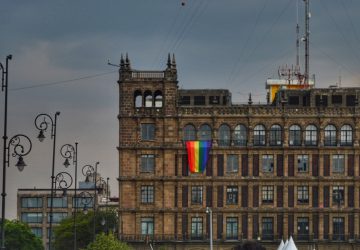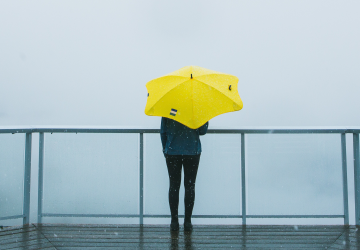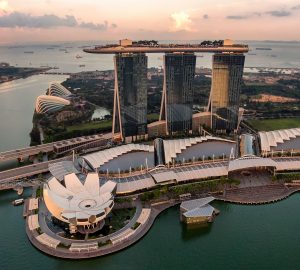Somewhere right now, either in your inbox, news feed or wherever you choose to take in your daily dose of world news, the words ‘Climate Change’ are probably lurking. We’ve become so accustomed to hearing about it, that we probably think we understand it. By now we’ve all heard that it has something to do with water levels rising and ice caps melting, and you know, all those things that Leonard DiCaprio and Al Gore are making documentaries about. But let’s face it, just like US elections and looking at what’s actually in our food; we know something is wrong and we know it matters, however most of us aren’t grasping the full severity of the situation. We were in the same boat, that is until we stumbled across the story of a globetrotting photographer and researcher who is putting a real face to climate change.
Lisa Murray is a freelance photographer and communications expert, working with NGOs all around the world. When we first came across her story, our imaginations ran wild with the promise of the stories she could share and the adventures she had lived through. And let us tell you, Lisa did not disappoint. We felt super lucky to catch up with her before she was jetting off to another remote corner of the world, leaving us re-thinking our entire life’s purpose. Over the past few years, she has travelled across Asia and Africa working with various organizations to better understand the effects of climate change on local communities. Her newest project, Faces of Change, strives to highlight the humanity behind climate change. We sat down with Lisa to discuss her project, and learn more about the passion that drives her to tackle such a huge issue.

Photo provided by Lisa Murray.
It was nearly 8pm in Kenya when our patchy skype call, with three different people on three different time zones, finally connected. Lisa’s charming accent, courtesy of her English roots was low, almost quiet. Us on the other hand, revved up on caffeine and excited for the chance to pick her brain, came at her with questions like a couple of traveler groupies who’d just met their hero. Lisa, phone crackling in the background, didn’t miss a beat.
“I remember the exact moment I become interested in travel, and even in development work. I met a Canadian woman in Ghana, I think she was a nurse or a doctor. She was working in the field on various projects and I just remember being so inspired by her. In that moment, I knew that somehow I wanted to work overseas in the field, doing some sort of good for the world. Though to be honest, at 14 years old I didn’t really understand what that meant or even what development work really was.”

Photo provided by Lisa Murray.
This opened her eyes to travelling, and she decided to take a gap year after school to travel around India and South East Asia. ‘When I first started travelling’, she tells us, with a hint of excitement starting to come through in her tone, ‘it was without any real purpose or plan. I was just backpacking around, as young people often do.’ She then went on to university, studying international development. She still felt as if she didn’t have much of a purpose, and began volunteering with various projects. At this point, she decided she wanted to get into research, and so began pursuing various internships. In a moment that would later define her work today, she ended up getting an internship doing research on climate change in India. It was the first time she had done research on this topic, and she was completely enthralled. A year or two later, she travelled out to Ethiopia to work on a piece of climate change research for an international charity in the area.
Whether out in the field under the hot African sun, or fighting for thin air at high elevations in the mountainous regions of Vietnam, Lisa always had her camera on hand and began to develop a keen interest in photography. “From a young age, I’d always wanted to get to know people and to learn more about their stories,” she says, “and photography became my way of doing that.” It’s important to keep in mind that these trips to remote areas did not have your typical ‘backpacker amenities’. With not much else to do in the field, she started taking photos of the local people and learning more about their lives. While the research she was doing was great for driving policy, she often felt that it did not capture the humanity behind the issues, which is what she felt would have a real impact in the long run.

Photo provided by Lisa Murray.
It was at this time that Lisa began to realize how important communications was for development organizations. Lisa began consulting as a photographer and communications expert for non-profit organizations, and without really meaning to, she continuously found herself working with various climate change projects.
Just last year, Lisa went to South Sudan to consult on a piece of ethnographic research. She admits that it was one of the most confronting and challenging experiences she has had to date, and where she has seen some of the most severe effects of climate change. As one local village elder she interviewed said, “The way rain used to rain, it has changed. The food we used to eat, is has changed. When I was young the rain came in April, this is when we started cultivating and at this time all the crops would be ready for eating. I don’t know what caused this? Maybe god is not happy, maybe there is something wrong with us?” There hasn’t been much research done on climate change in South Sudan, with the majority of resources allocated towards humanitarian initiatives. But that doesn’t mean there isn’t any hope.
“ What struck me the most after spending several months working in South Sudan, is just how much potential the country has (at least in terms of agriculture). Fifty percent of the country’s land is arable, but only four percent is cultivated at any one time. I witnessed men sitting around playing dominoes while their wives worked themselves to death trying to make ends meet. Inflation of food prices broke world records, yet surplus eggplants sell for next to nothing because people don’t know how to eat them. People can barely feed themselves in more peaceful areas, let alone in areas affected by conflict. Sadly, war and food insecurity is nothing new for the South Sudanese, it’s something they’ve endured for decades. Only now it’s being made so much worse by the added pressures of climate change, depleting resources and the economic crisis.”

Photo provided by Lisa Murray.
Having been confronted with a level of human suffering she hadn’t seen before, Lisa decided to it was time to start her own project, Faces of Change. She had collected all of these incredibly moving stories and photos that were not being utilized by the NGOs, and it was time to start sharing them with people. Especially with all of the things happening in the USA in the past year, she felt it was time to put a human face on climate change.
“Faces of Change is a way to get people to connect. It’s not just a tool to open their eyes in terms of climate changes, but also to better understand other peoples and theirs lives. I’m hoping that it will help people learn about and understand other cultures, and also to build empathy. A lot of my friends really didn’t have a clue about life outside of the UK. I’d say I was going to Africa or Vietnam and they would think I was living in mud huts all the time!”
Throughout her travels Lisa has met so many extraordinary people, but there have been few that stood out more than others. Again, she shares with us her passion for South Sudan and the people there, with infectious warmth now ringing in her voice. Even despite being very challenging environment to work in, with so much aid work required and a lot of effort just to meet basic needs, the stories of the people there have really hit home.
“I was with my small team doing research in a remote village and we were walking down a dirt road. These two women were walking up the dirt road, so we stopped to say hello. After chatting for a bit, we found out they were both widows. In South Sudan, a patriarchal society, once your husband dies it is very difficult to survive. The women’s cows had been taken by the family once their husband had died. It was also the hungry season, one of the worst times in South Sudan. They had walked 3 hours one way to a nearby forest to collect wild leaves, and they were just now on their way back. They showed me the inside of their bags, and there were only 2-3 handfuls of leaves in there, and that was what they were going to eat for the day. This will forever stick in my head as they had no other options, no prospects.”

Photo provided by Lisa Murray.
Though South Sudan has a lot of arable and fertile land, one of the main challenges is that people do not have the strength or tools to cultivate it. They become stuck in a poverty trap, once they are too weak to really work the land. It is also often the man’s job to prepare the land for agriculture, so if your husband dies, the women cannot physically cultivate very much. They are then forced to go searching for wild leaves or taking firewood to the market to sell. As Lisa has highlighted, the difficult truth is that they do not have any other options.
Still hanging on every word of her stories, as if we were right there with her, and nearly an hour into our call, Lisa shared her rule that after every interview, she offers the people she meets the chance to ask her any questions as well. She puts a lot of emphasis on getting to know the person, and on building trust. It is through this exercise that she has often been asked about marriage, and most people can’t believe she isn’t married yet. They find this so strange, even though in contrast, we would likely find their polygamist traditions or age of marriage to be bizarre. These drastically different views allow us to change our perspective and reduce our judgment.
Despite these differences, there are also similarities. For example, in Dinka culture, when they get to adulthood they pull out their bottom front teeth and the men etch tribal scars across their foreheads. Lisa sometimes teaches, and when she shares these cultural traditions with her classes, they can’t help but think it is weird. However, she draws parallels in this artistic expression with our preference for ear piercings and tattoos. It highlights that perhaps we are not all so different after all!

Photo provided by Lisa Murray.
Lisa is hoping that not only will Faces of Change help us all connect a bit more with other people’s lives, but also to understand that climate change is real and it’s having serious negative effects. We need to be mindful with our actions, and support each other in any way we can.
We didn’t want to the call to end, like a child whose bedtime story finished far too soon. And Lisa was exceedingly gracious and too polite to tell us that in all likelihood, she was exhausted. So we wrapped up with one last question, asking what, or better stated, where was next? For Lisa, it was Vietnam and then back to Kenya, which is now her home base. She will continue to collect and share stories, and you can follow her project, Faces of Change, on her website. And maybe, if you’re lucky, you may just cross paths on one of your trips and have the chance to sit beside her on that bar stool and hear one of her stories. Hopefully at that point, thanks to her work, with a far better understanding of both yourself and the effects of climate change.
For more info, and to follow along on Lisa’s adventure, check out her website and social channels below.
Website: Faces of Change | Instagram: Faces of Change | Instagram: Lisa Murray

Photo provided by Lisa Murray.
Source: Kosan








